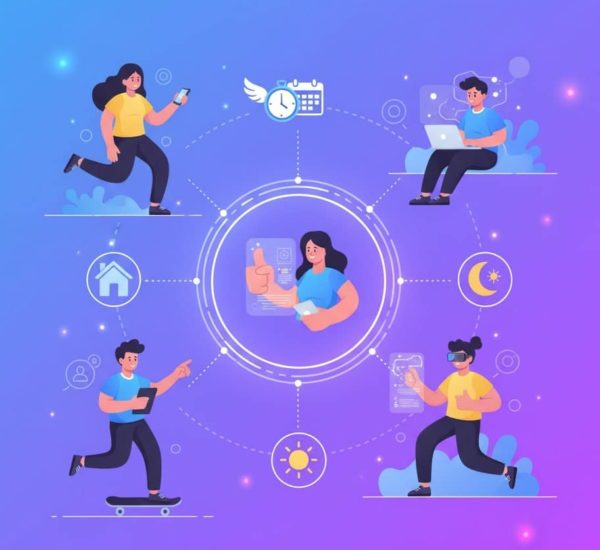For HR managers and People Ops leaders, the pressure is real: deliver higher output with the same headcount—or less. Leadership is pushing for performance gains, but on the ground, you’re seeing signs of fatigue. Team members are working longer hours, yet the results don’t add up. Productivity is stalling, morale is dipping, and burnout is creeping in. This isn’t a matter of motivation—it’s a matter of math. Welcome to the productivity paradox, where more time spent working doesn’t equal more done. In fact, the longer your team pushes past their limits, the more you run into diminishing returns on work. If you’re trying to make the case for smarter, more sustainable productivity strategies, the science is on your side.
Let’s break down why the “more hours = more output” mindset is flawed—and what to do instead.
The Hidden Costs of Overwork: Burnout, Turnover, and Lost Output
When teams put in extra hours without proper support or boundaries, they don’t become more productive—they become exhausted. And that exhaustion carries long-term consequences that organizations can’t afford to ignore.
Burnout is officially recognized by the World Health Organization as a workplace syndrome, and it’s more than just feeling tired. It leads to chronic stress, disengagement, and reduced performance. According to Gallup, burned-out employees are:
- 63% more likely to take a sick day
- 2.6 times more likely to actively seek a new job
- 13% less confident in their own performance
On top of that, overwork often triggers:
- Decreased morale and engagement—employees lose motivation and discretionary effort.
- Increased errors—as cognitive function declines with fatigue, quality drops.
- Presenteeism—workers are physically present but mentally checked out, costing companies up to $1,500 per employee per year, according to the Integrated Benefits Institute.
These effects illustrate the diminishing returns on work. As hours go up, the benefits don’t just flatten—they often reverse. And the longer teams operate at an unsustainable pace, the harder it is to recover performance and morale.
It’s a clear case of the productivity paradox in action: the more you ask of exhausted employees, the less you’re likely to get in return.
 Understanding the Productivity Paradox
Understanding the Productivity Paradox
At first glance, it makes sense: if you want to get more done, put in more time. But the productivity paradox challenges that logic. It refers to the phenomenon where increasing hours worked doesn’t result in proportional gains—and can even lead to lower productivity overall.
This isn’t just theory. A well-known Stanford study found that productivity per hour declines sharply when the workweek exceeds 50 hours. After 55 hours, output drops so significantly that putting in extra time becomes pointless. In other words, an employee working 70 hours a week often gets the same—or less—done than one working 55.
This decline is tied directly to diminishing returns on work. As mental fatigue sets in, employees take longer to complete tasks, make more errors, and struggle to prioritize effectively. Beyond a certain point, those extra hours aren’t adding value—they’re creating waste.
When organizations rely on longer hours to boost performance, they’re missing a key truth: it’s not just about time spent—it’s about how that time is used. That’s where efficiency vs. hours worked becomes a more useful lens.
Using Data to Fight the “Hours = Output” Myth
To shift mindsets at the top, HR leaders need more than intuition—they need proof. And the best way to challenge the “more hours means more productivity” mindset is to show the data that says otherwise.
Smart teams are leveraging time-tracking insights to surface inefficiencies, not to monitor individuals, but to highlight broken systems, bloated meetings, and context-switching overload. For example:
- Are teams spending six hours a week in recurring meetings that rarely generate outcomes?
- Are top performers getting bogged down by administrative tasks that could be automated?
- Are employees clocking in long hours but breaking focus every 15 minutes due to constant Slack pings?
Tools like AttendanceBot can help teams identify patterns around working hours, breaks, and overtime. Paired with pulse surveys or engagement check-ins, this data creates a compelling narrative: employees aren’t slacking—they’re stretched thin by invisible inefficiencies.
This kind of analysis reframes the conversation. It’s not about working less—it’s about working better. And that’s a message leadership is far more likely to support when backed by evidence. This lens can extend beyond performance data—many teams are also reviewing time logs, shift patterns, and payroll operations to uncover hidden inefficiencies. For example, platforms like Hybrid Payroll help HR leaders simplify time tracking and payroll workflows, giving them clearer insights into where hours are going—and where they shouldn’t be.
Smarter, Not Harder: HR Strategies That Boost Output Without Burnout
Once you’ve made the case with data, the next move is clear: redesign how work gets done. These strategies help teams operate at peak efficiency—without pushing them past their limits.
1. Redefine What “Productive” Looks Like
The productivity paradox isn’t about clocking more hours—it’s about creating value. Shift your internal benchmarks from time-based metrics (like hours online) to outcome-based goals. This helps employees prioritize impact over busywork and gives managers clearer ways to evaluate performance.
2. Protect Deep Work
Context switching kills productivity. Studies show it can take 20-25 minutes to regain focus after an interruption. Reduce distractions by encouraging meeting-free blocks, turning off non-urgent notifications, and using Slack status updates to signal when someone’s in focus mode.
3. Audit and Eliminate Low-Value Tasks
Partner with team leads to audit recurring meetings, report cycles, or duplicated workflows. Eliminate or streamline anything that doesn’t drive results. Encourage the use of automations—tools like AttendanceBot can help log time, handle leave approvals, and reduce admin overhead.
4. Set Boundaries Around Work Hours
Normalize signing off at a reasonable hour. Use time tracking data to identify employees consistently working overtime and check in on workload distribution. If someone’s logging 10-hour days, it may be a resource gap—not a performance issue.
5. Champion Recovery as a Performance Strategy
Downtime isn’t a luxury—it’s a requirement. Encourage PTO usage, model breaks at leadership levels, and remind teams that rest fuels high performance. A Deloitte study found that lack of support for well-being was a top driver of burnout—HR has the power to change that narrative.
You’re right—we haven’t touched on real-world use cases or examples, which are essential for making this content stick. They help HR leaders see themselves in the story and visualize how to act on the strategies.
Let’s add a new section that brings the advice to life by showing how companies (fictionalized but realistic) used time data and smarter work practices to boost output without burning out their teams.
Real-World Wins: How Teams Increased Output Without More Hours
Sometimes the best way to prove something works is to show it in action. Here are a few use cases that spotlight how companies improved performance by rethinking the “work more, get more” mindset.
Tech Startup Reduces Overtime by 32% Using Time Insights
A 40-person SaaS company noticed engineers were consistently logging 10+ hour days—but feature velocity hadn’t improved. By using a time tracking tool like AttendanceBot to analyze working hours and team check-ins, HR discovered the issue: frequent context switching caused by ad-hoc meetings and Slack pings.
They implemented two-hour “deep work” windows, muted internal notifications, and cut non-essential standups. Within a quarter, average weekly overtime dropped by 32%, and bug resolution rates improved by 18%.
Consulting Firm Replaces Meeting Overload With Async Updates
A mid-sized professional services firm was drowning in meetings. Team members averaged 23 hours per week in scheduled calls, leaving little time for focused work. HR partnered with team leads to replace daily syncs with async updates via Slack workflows and AttendanceBot reminders.
The result? Employees reported feeling “less rushed” and “more in control,” and on-time project delivery improved by 21% within two months—without adding a single hour of work.
Creative Agency Ties PTO Usage to Output, Not Presence
A creative agency noticed designers were hesitant to take time off—even when burned out—because leaders unconsciously equated presence with commitment. HR introduced a policy update: success would be measured by client impact, not online status. They used time off and work tracking data to identify and reward smart time usage, not long hours.
The culture shift increased PTO usage by 46% in six months, with no drop in client satisfaction—and a noticeable boost in creative quality.

Essential Tools to Implement Smarter Work Practices
To turn these strategies into real, measurable outcomes, HR teams need the right tools. Here’s a roundup of the best resources that help track work patterns, automate time management, and promote a healthier, more efficient work environment:
Time-Tracking Software That Works for Everyone
It’s no longer just about tracking hours—it’s about understanding where time is spent and improving efficiency. Tools like AttendanceBot let teams automatically log work hours, breaks, and leave requests without adding administrative burden. These insights give HR leaders the data they need to identify burnout, optimize team schedules, and prevent overtime from creeping up.
Employee Engagement and Pulse Surveys
Regular check-ins and pulse surveys (like those available on SurveyMonkey or 15Five) give employees a safe space to communicate workload stress, morale, and job satisfaction. By incorporating these surveys into your strategy, HR can spot early signs of burnout, gather actionable feedback, and implement necessary changes—before teams reach the breaking point.
Async Collaboration Tools
For teams struggling with meeting overload, moving toward asynchronous communication can free up time for deep work. Platforms like Notion and Slack with custom workflows allow teams to track tasks, share updates, and collaborate without interrupting each other’s focus. In fact, moving to async updates can reduce context-switching, leading to more sustained productivity.
AI-Powered Work Optimization
AI tools like Clockify or RescueTime automatically track how much time is spent on productive tasks vs. distractions. These tools can help employees self-monitor their focus patterns and give HR leaders insights into how to improve team workflows. By identifying bottlenecks or underutilized time, you can implement more efficient scheduling and reduce unnecessary overtime.
Flexible Scheduling Tools
Employees need flexibility to manage their own time and workload. Platforms like When I Work and Flextime allow teams to create and manage personalized schedules. By implementing flexible scheduling, you can allow your employees to work when they’re most productive—reducing the need for long hours and improving overall performance.
By leveraging these tools, HR professionals can create a sustainable, high-performing environment that prioritizes well-being and output. The key takeaway? Work smarter, not longer.
Conclusion: Work Smarter, Not Longer, is the Productivity Paradox
Longer hours don’t equal better productivity. By focusing on smarter work practices, HR leaders can boost performance while safeguarding employee well-being. It’s time to challenge the “more hours = more output” mindset and embrace strategies that create sustainable productivity for the long haul.

 Understanding the Productivity Paradox
Understanding the Productivity Paradox

